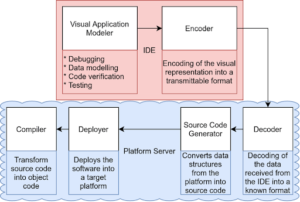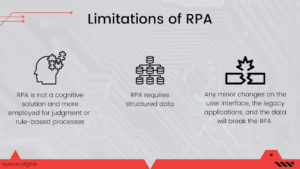In an age of rapid changes and increasing competition between companies, low-code development is something that you have to consider adopting in order to implement a better digital transformation strategy. This is a strategy that will help your organization out pace competition, function better, perform more efficiently and take operations to the next level. Meanwhile, there are a plethora of methods and tools out there that have the ability to simplify the development processes and reduce the current dependency on developers. These help companies increase productivity and generate significant revenue. Code automation sits at the top of any digital transformation hierarchy.
Two of the most popular technologies for automation in recent years are Robotic Process Automation (RPA) and low-code development platforms. While each has its own benefits and uses, it is important to identify the differences between these two solutions. Below, we explore the primary benefits of Low-code automation and identify why we suggest you use it instead of RPA.
1. Low-code on the rise
Low-code platforms are built to address the need for simplification of the rigorous and time-consuming process of building applications from scratch. Gartner forecasts revealed that the low-code development technologies market will expand by 23% in 2021, making it worth 13.8 Billion USD globally. Also, more than 50% of SMEs and MNCs will incorporate low-code and no-code platforms into their IT strategy.
1.1. How does it work?
Low-code platforms use a graphical user interface as a development environment to build software applications, distinguishing them from traditional programming. They also take a more visual approach to programming, using pre-existing blocks of code in a simple drag and drop methodology. One can build the application workflows seamlessly, massively cutting down on the development time. This also means that a wider range of people can mastermind an application’s development, irrespective of their coding experience, level or background.

The low-code architecture
Source: Research Gate
1.2. Cost-effective and efficient
Low-code platforms help organizations fast-track digital transformation by allowing them to quickly respond to the customer needs and demands across all channels.
The low-code platforms come with a lower cost in terms of initial set-up, training, deployment & maintenance, and have the capability to produce fully functional and operational applications, with the occasional need of additional coding.
In quest of agility and scalability, many organizations have moved their applications and infrastructure onto the cloud and even created micro-services & API ecosystems, and low-code facilitates these services. As time is money when it comes to app development, in a variety of ways low code injects blistering speed and productivity into the development process, thus saving you money.

Source: PMAg India
To get in-depth knowledge about the low-code approach, just drop a request to Kyanon Digital and we will mail you our white paper on All you need to know about low-code platform 2021.
Futher reading:
2. Understanding Robotic Process Automation (RPA)

RPA systems allow businesses to automate the time-consuming, repetitive, mundane tasks within applications. You may find it similar to the macro recorder in Microsoft Excel.
RPA doesn’t directly interfere with the underlying IT systems, rather the RPA bots just access the computer system like a human would through UI or Login/Password. This means that the systems do not need to be re-engineered and the infrastructure does not need to be altered. RPA applications simply sit on top of the existing IT applications and augment. Then they employ a recorder to create software scripts and learn activities.
RPA is a spot-on choice for organizations running legacy applications and it is a terrific technology bringing a fresh breeze through digital process flows. The ability to automate mechanical and regular processes that don’t offer much value but require a lot of time in back-office applications, is quite useful for industries like banking, insurance, finance, healthcare, utilities, and telecommunications. Repetitive swivel-chair-based processes can be easily automated, and with the programmed bots, human errors are eliminated.
Limitations of RPA

- RPA is not a cognitive solution and it is more employed for judgment or rule-based processes, for instance bank loan approvals based on set criteria.
- RPA requires structured data while most of organizational data is buried in unstructured documents. There are however certain tools that can be used to help with this.
- Any minor changes on the user interface or the legacy applications, and the data will break the RPA.
To sum it up, RPA is a good fit for “one-off” initiatives where investing a developer’s resources isn’t necessary. Given certain limitations, it might soon emerge as Smart Process Automation, powered by AI and MI to get to a new level of efficiency.
Transform your ideas into reality with our services. Get started today!
Our team will contact you within 24 hours.
3. Low-code’s edge over RPA
Companies such as Microsoft, AWS, and Google have been investing in the low-code by compiling a range of products. This is a big threat to the leading RPA companies including BluePrism, UI Path, and Automation Anywhere, on whom many enterprises rely for the automation of their processes. Microsoft’s approach is to bring low-code software into the enterprise’s existing CI/CD workflows. As the momentum shifts on to low-code development, here are a few reasons why you should choose it over RPA:

3.1. The agile low-code
Most of the time, you are obliged to get rid of an old application and create an entirely new one in order to adapt to your current requirements, rather than mending and tweaking your old application the way low-code enables you to do. Thanks to low-code’s built-in codes and workflows, firms are able to become more agile in the long run by reducing the amount of coding they need and by automating their testing.
3.2. Flexibility
RPA is a powerful tool known for being slow to change and innovate, and less flexible, but low-code allows for easy adjustments and adaptations to meet new requirements. It also streamlines the engineering process and makes system restructuring easier. With the speed offered by low-code, businesses can experiment with new products in order to quickly adapt to the changing needs of the market.
3.3. Enhanced applications
If you need to enhance your current applications RPA won’t help because it will only be programmed over an existing configuration. Instead, applying low-code to add features or completely redesign is not only quicker but also more economical.
3.4. Easy to manage
RPA Bots need management, maintenance, and security. In the case of low-code, regular maintenance is reduced by the availability of ready-to-use templates and the simplified development procedure. It also lowers the number of bugs, making the procedure easier and less stressful.
3.5. Time matters
Both low-code systems and RPA will help boost productivity by allowing us to do more in less time, so that you can focus on other challenging or interesting projects. However, in the case of RPA, a complicated setup is required and it takes a fair bit of time to identify and analyze the chosen process to be automated. Low-code is about creating applications at the same speed of ideation and benefits the organization with agility and automated testing in the long run.
4. Conclusion
There is no doubt that low-code platforms are changing the landscape of software application development and gaining prominence across industries. In the post-pandemic era, where organizations have to integrate more remote solutions than ever, these platforms are vital for accelerating digital modernization.
Although RPA and low-code both have their own set of use-cases, benefits and drawbacks, with the growing requirement for rapid innovation, RPA’s vulnerability to change is a major challenge for most businesses. Broadly, it can be said that RPA belongs in the bigger low-code family, just that the development in RPA is for the Robots. And in some cases, the combination of RPA and low-code can be powerful. So utilizing each to its own strengths would be a wise call.

At Kyanon Digital, our team of experts knows exactly how to balance the use of low-code platforms to speed up enterprise application delivery. For more information, please visit our low-code service webpage where you can also refer to some of our recent case studies.


















